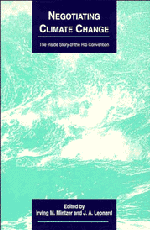Book contents
- Frontmatter
- Contents
- Acknowledgements
- Commonly Used Acronyms
- Foreword
- Part I Background
- Part II Views from Within the Ring
- 3 Exercising Common but Differentiated Responsibility
- 4 The Beginnings of an International Climate Law
- 5 Constructive Damage to the Status Quo
- 6 The Climate Change Negotiations
- 7 A Personal Assessment
- 8 The Road to Rio
- 9 A Failure of Presidential Leadership
- 10 Looking Back to See Forward
- Part III The Outside Edges In
- Part IV Prospects for the Future
- Appendix: The Framework Convention on Climate Change
- Index
9 - A Failure of Presidential Leadership
Published online by Cambridge University Press: 01 June 2011
- Frontmatter
- Contents
- Acknowledgements
- Commonly Used Acronyms
- Foreword
- Part I Background
- Part II Views from Within the Ring
- 3 Exercising Common but Differentiated Responsibility
- 4 The Beginnings of an International Climate Law
- 5 Constructive Damage to the Status Quo
- 6 The Climate Change Negotiations
- 7 A Personal Assessment
- 8 The Road to Rio
- 9 A Failure of Presidential Leadership
- 10 Looking Back to See Forward
- Part III The Outside Edges In
- Part IV Prospects for the Future
- Appendix: The Framework Convention on Climate Change
- Index
Summary
Prologue
The framework convention on climate change was signed by 154 countries at the Earth Summit in Rio de Janeiro in June 1992. It represents—simultaneously—a success for United States diplomacy, a long-standing tension in American foreign policy, and a failure of presidential leadership.
There is little question that the climate change issue presents a difficult foreign policy challenge to the United States. The US is in the unenviable position of being at the same time the world's largest emitter of carbon dioxide and other greenhouse gases, the recognized leader of the international system, and the home of the world's most influential environmental organizations. The US therefore has no place to hide from the climate change issue at home or abroad and is universally perceived as both the largest part of the problem and the largest part of the solution. As much as President Bush and his closest associates may have wished for this issue simply to go away, it has refused to do so. In these circumstances, it is perhaps surprising that the final agreement signed in Rio is as well-designed and as forward-looking as it is.
- Type
- Chapter
- Information
- Negotiating Climate ChangeThe Inside Story of the Rio Convention, pp. 187 - 200Publisher: Cambridge University PressPrint publication year: 1994
- 4
- Cited by



